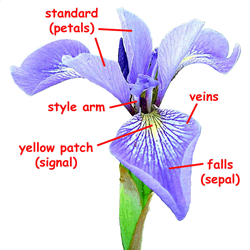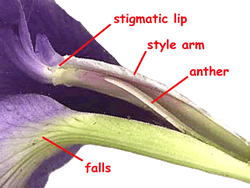USDA Forest Service Celebrating Wildflowers
|
|
|
Beauty of It AllThe Iris Flower
The competition for pollinators is intense evolving in a habitat where numerous other species of flowering plants are blooming at the same time. Irises have developed a highly specialized flower. The blossoms are very large and colorful. In Figure 1, the sepals (sometimes called “falls”) are recurved in such a manner to provide a landing pad for bumblebees. The petals (sometimes called “standards”) are upright and colorful, adding to the overall attractiveness of the flower to bumblebees. The striking and colorful veining on the sepals directs bumblebees down into a tight space between the sepal and style arm. The style arm (Figure 2) is a highly modified pistil that connects the stigmatic lip to the ovary. While crawling down toward the nectar glands, pollen rubs off the back of the pollinator and attaches to the sticky stigmatic lip. Moving ever forward, the bumblebees’ backs come in contact with the pollen-producing anthers on the stamen where they pick up additional pollen. Botanists believe that this relatively large and colorful modified pistil adds to the overall attractiveness of the blossom to bumblebees. |
|
| NOTE: PDF format links require the Adobe Acrobat Reader to view. | |
| top | Disclaimers | FOIA | Privacy Policy | Quality of Information | Photo Credits & Use |
Location: http://www.fs.fed.us/wildflowers/beauty/iris/flowers.shtml
Last modified: Tuesday, 24-Jun-2008 21:58:13 EDT

